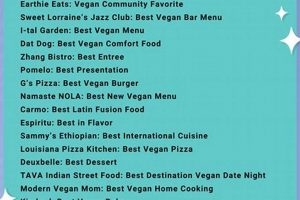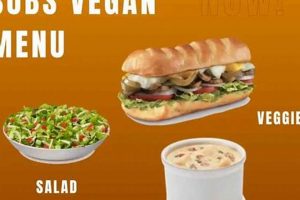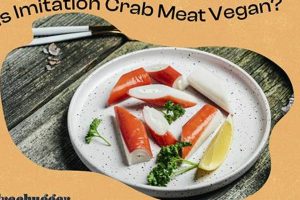A plant-based breakfast option derived from rolled or steel-cut oats prepared without animal products constitutes a readily available and customizable meal. Recipes typically incorporate water or plant-based milk alternatives, such as almond, soy, or oat milk, and frequently include sweeteners like maple syrup or agave nectar, along with toppings like fruits, nuts, and seeds. This adaptable dish caters to diverse dietary preferences and nutritional requirements.
The value of this breakfast choice stems from its inherent nutritional profile and ethical considerations. Oats are a source of soluble fiber, which may contribute to improved cardiovascular health. Furthermore, opting for plant-based ingredients aligns with vegan principles, promoting animal welfare and often reducing environmental impact compared to animal-derived products. The historical consumption of oats as a staple food underlines its accessibility and affordability as a nutritional resource.
The subsequent sections will delve into specific preparation methods, examine the nutritional advantages in greater detail, and explore creative variations that enhance palatability and nutritional value. A detailed ingredient analysis will further clarify the suitability of this option within various dietary frameworks.
Preparation and Enhancement Strategies
The following recommendations aim to optimize the nutritional value and culinary appeal of this dish, ensuring a satisfying and healthful breakfast experience.
Tip 1: Opt for Whole Grain Varieties: Steel-cut or rolled oats, as opposed to instant oats, retain more fiber and nutrients. These less processed options provide sustained energy release and improved satiety.
Tip 2: Utilize Plant-Based Milk Alternatives: Employ unsweetened almond, soy, or oat milk to augment creaminess and flavor while minimizing added sugars and saturated fats. Consider the nutritional profile of each milk alternative to align with individual dietary needs.
Tip 3: Incorporate Natural Sweeteners Judiciously: Employ maple syrup, agave nectar, or date syrup sparingly to enhance sweetness without excessive sugar intake. Fruit purees, such as mashed banana or applesauce, can also provide natural sweetness and additional nutrients.
Tip 4: Enhance Nutritional Density with Seeds: Add chia seeds, flax seeds, or hemp seeds to boost omega-3 fatty acid, fiber, and protein content. These seeds can be incorporated during cooking or sprinkled on top before serving.
Tip 5: Include Fresh or Frozen Fruits: Berries, bananas, apples, and other fruits provide vitamins, minerals, and antioxidants. Frozen fruits offer a convenient and cost-effective alternative, particularly during off-seasons.
Tip 6: Integrate Nut Butters for Sustained Energy: A tablespoon of almond butter, peanut butter, or cashew butter contributes healthy fats and protein, promoting satiety and sustained energy levels. Choose nut butters with minimal added ingredients.
Tip 7: Experiment with Spices and Extracts: Cinnamon, nutmeg, vanilla extract, or almond extract can enhance flavor complexity without adding significant calories or sugar. These additions offer opportunities for culinary creativity.
Adhering to these strategies allows for the creation of a nutritionally balanced and palatable breakfast, suitable for individuals seeking a plant-based and health-conscious dietary option.
The subsequent section will address potential ingredient substitutions and modifications to accommodate specific dietary restrictions and preferences, further expanding the versatility of this breakfast staple.
1. Plant-based milk
The relationship between plant-based milk and this plant-based breakfast is one of necessity and enhancement. As the foundation of a vegan diet precludes the use of dairy milk, plant-based alternatives become essential liquids for cooking the oats. The absence of plant-based milk options would fundamentally alter the dish, potentially rendering it unpalatable or nutritionally deficient due to reliance solely on water. For example, using almond milk in the dish contributes a subtle nutty flavor and enhances the creamy texture, thereby improving the overall sensory experience. Similarly, soy milk provides a higher protein content compared to some other plant-based milks, directly influencing the nutritional profile.
The selection of specific plant-based milk influences several factors: flavor, texture, nutritional value, and even environmental impact. Oat milk contributes to a naturally sweet flavor profile and a creamy consistency, making it a popular choice. Coconut milk, although richer in saturated fat, imparts a distinct tropical flavor. Rice milk, being naturally sweeter, requires less added sweetener. Commercially available plant-based milks are often fortified with vitamins and minerals, such as vitamin D and calcium, further enhancing the nutritional value of the plant-based breakfast. The practical significance lies in tailoring the choice of plant-based milk to align with individual dietary needs, preferences, and ethical considerations.
In summary, plant-based milk is not merely a substitute but an integral component contributing to the character and nutritional completeness of this dish. The challenges involve navigating the wide variety of options and understanding their unique properties. The increasing availability and diversity of plant-based milks reflects the broader trend towards plant-based diets and the importance of finding suitable and sustainable alternatives to animal products in common culinary applications. The choice has a direct impact on the taste, nutritional value, and environmental footprint of the final product.
2. Whole grain oats
The presence of whole grain oats constitutes a cornerstone of nutritional integrity within vegan oatmeal. Their unrefined nature offers distinct advantages compared to processed or refined oat varieties, thereby influencing both the nutritional profile and the sustained energy release of the resulting dish.
- Fiber Content and Digestive Health
Whole grain oats retain the bran and germ, resulting in a significantly higher fiber content than processed oats. This fiber aids in promoting digestive regularity, preventing constipation, and fostering a healthy gut microbiome. Within vegan oatmeal, this translates to a breakfast that provides sustained satiety and contributes to overall gastrointestinal well-being.
- Glycemic Index and Blood Sugar Regulation
Due to the presence of fiber, whole grain oats exhibit a lower glycemic index compared to instant or refined oats. This slower rate of digestion and absorption leads to a more gradual increase in blood sugar levels, preventing energy crashes and promoting stable energy throughout the morning. This is particularly beneficial for individuals managing blood sugar levels or seeking sustained energy without the subsequent dip.
- Nutrient Density and Micronutrient Profile
Whole grain oats are a source of essential nutrients, including manganese, phosphorus, magnesium, and iron. These micronutrients play vital roles in various bodily functions, such as energy production, bone health, and immune function. Including whole grain oats in vegan oatmeal contributes to a more nutrient-dense breakfast, offering a broader spectrum of essential vitamins and minerals.
- Satiety and Weight Management
The high fiber content of whole grain oats promotes feelings of fullness and satiety, which can assist in weight management by reducing overall calorie intake. This satiating effect, combined with the sustained energy release, makes vegan oatmeal with whole grain oats a suitable option for individuals seeking to control their weight or maintain a healthy body composition.
The utilization of whole grain oats in vegan oatmeal extends beyond mere ingredient selection; it represents a deliberate choice to prioritize nutritional value and sustained energy. By retaining the bran and germ, these oats offer a superior fiber and micronutrient profile, contributing to digestive health, blood sugar regulation, and overall well-being. This highlights the integral role of whole grain oats in delivering the nutritional benefits associated with this breakfast option.
3. Natural sweeteners
The incorporation of natural sweeteners into vegan oatmeal addresses a critical aspect of palatability while adhering to dietary principles. The causal relationship is straightforward: absent the sweetness provided by such agents, the inherent flavor of oats may prove unappealing to many, thereby reducing adherence to this potentially nutritious breakfast option. Their importance stems from the ability to enhance taste without relying on refined sugars, which are often discouraged due to their impact on blood glucose levels and overall health. Examples include maple syrup, agave nectar, date syrup, and fruit purees (such as mashed bananas or applesauce). These options provide varying degrees of sweetness and impart distinct flavor profiles, catering to individual preferences. The practical significance lies in optimizing the sensory experience of the breakfast, making it more sustainable as a long-term dietary choice.
Further analysis reveals a complex interplay between the type of natural sweetener and its nutritional consequences. Maple syrup, while offering a characteristic flavor, contains a relatively high glycemic index, necessitating moderation. Agave nectar, conversely, boasts a lower glycemic index but may be perceived as excessively sweet by some. Date syrup provides a concentrated source of minerals and antioxidants, adding nutritional value beyond mere sweetness. Fruit purees contribute fiber and vitamins alongside their sweetening properties. The choice of sweetener thus entails a trade-off between flavor, glycemic impact, and nutritional density. A real-life example involves an individual with diabetes opting for a small amount of date syrup combined with a larger portion of berries to achieve desired sweetness while minimizing blood sugar fluctuations. Practical applications include experimenting with different combinations and quantities of natural sweeteners to achieve the optimal balance of taste and health benefits.
In summary, natural sweeteners play a pivotal role in transforming plain oats into a palatable and sustainable vegan breakfast. Careful consideration of their individual properties is essential to maximize their benefits while minimizing potential drawbacks. The challenge lies in achieving optimal sweetness without compromising nutritional value or blood sugar control. The connection to the broader theme of healthy eating resides in promoting a balanced and enjoyable dietary pattern that supports long-term adherence and overall well-being.
4. Seeds and nuts
The integration of seeds and nuts into vegan oatmeal represents a strategic enhancement of its nutritional profile and textural complexity. These additions transcend mere flavoring agents, contributing significantly to the dish’s overall satiety and health benefits.
- Enhanced Macronutrient Composition
Seeds and nuts contribute essential fatty acids, protein, and fiber, augmenting the macronutrient balance of vegan oatmeal. Flax seeds and chia seeds, for instance, are rich in omega-3 fatty acids, which possess anti-inflammatory properties. Nuts like almonds and walnuts offer substantial amounts of protein and healthy fats, promoting satiety and sustained energy levels. These components are particularly valuable in a vegan diet, where obtaining adequate protein and essential fats can require careful planning.
- Micronutrient Enrichment
Beyond macronutrients, seeds and nuts introduce a spectrum of micronutrients. Pumpkin seeds are a source of magnesium and zinc, while almonds provide vitamin E and calcium. These micronutrients play critical roles in various physiological processes, including immune function, bone health, and antioxidant defense. Their presence enhances the nutritional density of vegan oatmeal, contributing to a more comprehensive dietary intake.
- Textural Variation and Sensory Appeal
The addition of seeds and nuts transforms the texture of vegan oatmeal, introducing elements of crunch and chewiness that contrast with the soft consistency of the cooked oats. This textural variation enhances the sensory experience, making the dish more appealing and satisfying. Toasted nuts, in particular, release aromatic compounds that further contribute to the overall flavor profile.
- Blood Sugar Regulation
The fiber and fat content of seeds and nuts can moderate the glycemic response to vegan oatmeal. These components slow down the absorption of carbohydrates, preventing rapid spikes in blood sugar levels and promoting more stable energy release. This effect is particularly beneficial for individuals with insulin resistance or diabetes.
The strategic incorporation of seeds and nuts elevates vegan oatmeal from a simple carbohydrate source to a nutritionally complete and sensorially satisfying meal. The diverse range of seeds and nuts available allows for customization based on individual preferences and dietary needs, further enhancing the versatility and appeal of this plant-based breakfast option.
5. Fruits and spices
The integration of fruits and spices into vegan oatmeal transcends mere flavor enhancement, significantly influencing its nutritional profile and sensory experience. These components serve as integral elements in transforming a basic oat-based dish into a more complex and appealing meal.
- Micronutrient Enrichment and Antioxidant Provision
Fruits contribute a diverse array of vitamins, minerals, and antioxidants to vegan oatmeal. Berries, for example, are rich in vitamin C and anthocyanins, providing potent antioxidant protection against cellular damage. Bananas offer potassium, essential for electrolyte balance and muscle function. The strategic selection of fruits can significantly enhance the micronutrient density of the dish, promoting overall health and well-being.
- Fiber Enhancement and Digestive Support
Many fruits, such as apples and pears, are high in dietary fiber, both soluble and insoluble. This fiber promotes digestive regularity, prevents constipation, and contributes to a healthy gut microbiome. When added to vegan oatmeal, fruits augment the fiber content, enhancing its digestive benefits and promoting satiety.
- Flavor Complexity and Aromatic Nuance
Spices introduce layers of flavor complexity and aromatic nuance to vegan oatmeal. Cinnamon, nutmeg, and ginger, for instance, impart warmth and depth, complementing the mild flavor of the oats. These spices possess inherent bioactive compounds with potential health benefits, such as anti-inflammatory and antioxidant properties. The judicious use of spices can elevate the sensory experience, making the dish more satisfying and appealing.
- Natural Sweetening and Reduced Refined Sugar Reliance
Fruits provide a natural source of sweetness, reducing the need for added refined sugars in vegan oatmeal. The inherent sugars in fruits, such as fructose and glucose, offer a healthier alternative to processed sweeteners. This approach aligns with dietary recommendations to limit added sugar intake and promote the consumption of whole, unprocessed foods.
The deliberate inclusion of fruits and spices in vegan oatmeal transforms it from a simple carbohydrate source into a nutritionally diverse and sensorially appealing meal. The synergistic combination of these components enhances the dish’s micronutrient profile, fiber content, flavor complexity, and natural sweetness, making it a compelling option for individuals seeking a healthy and satisfying plant-based breakfast.
6. Cooking methods
The chosen cooking method exerts a significant influence on the texture, digestibility, and nutritional value of vegan oatmeal. Raw oats, while theoretically consumable, are generally unpalatable and less digestible due to the presence of phytic acid, which can inhibit nutrient absorption. Consequently, the application of heat is necessary to render the oats more palatable, improve digestibility, and potentially reduce the impact of phytic acid. Different methods impart distinct characteristics. For instance, stovetop cooking, a traditional approach, allows for precise control over the consistency of the oatmeal. The prolonged simmering process can result in a creamier texture as the starches in the oats gelatinize. Conversely, microwave cooking offers speed and convenience but may result in a less uniform texture due to uneven heat distribution. The selection of cooking technique directly impacts the final product’s qualities, affecting its appeal and nutritional bioavailability.
Further exploration reveals that overnight oats, a no-cook method, offer an alternative approach. Soaking oats in plant-based milk overnight initiates a process of enzymatic activity that can improve digestibility and reduce phytic acid content without the application of heat. This method typically yields a softer, chewier texture. Pressure cooking, another option, significantly reduces cooking time and can enhance the gelatinization of starches, resulting in a particularly creamy texture. However, improper pressure cooking can lead to scorching or inconsistent results. A practical example involves an individual with digestive sensitivities who finds overnight oats more easily digestible than stovetop-cooked oatmeal. The method also can influence nutrient preservation; prolonged high-heat cooking may degrade certain vitamins, while shorter cooking times or no-cook methods may retain a higher concentration of heat-sensitive nutrients.
In summary, the cooking method is not a mere procedural step but an integral determinant of the final characteristics of vegan oatmeal. The choice among stovetop cooking, microwave cooking, overnight soaking, or pressure cooking significantly influences texture, digestibility, and potentially nutrient retention. Challenges involve selecting the optimal method based on individual preferences, time constraints, and specific dietary needs. Understanding the impact of each cooking technique is crucial for maximizing the enjoyment and nutritional benefits of this breakfast staple, aligning with the broader theme of informed food preparation and mindful consumption.
Frequently Asked Questions About Vegan Oatmeal
The following questions address common concerns and misconceptions surrounding the preparation, nutritional value, and suitability of vegan oatmeal as a dietary choice.
Question 1: Does vegan oatmeal provide sufficient protein for a balanced diet?
Vegan oatmeal, in its base form, offers a moderate amount of protein. Augmenting the recipe with ingredients such as nuts, seeds, or plant-based protein powder can significantly increase the protein content, aligning it with recommended daily intakes.
Question 2: Is vegan oatmeal suitable for individuals with gluten sensitivities?
Oats are inherently gluten-free. However, cross-contamination during processing and packaging can occur. Individuals with celiac disease or gluten sensitivities should select certified gluten-free oats to ensure safety.
Question 3: How does the nutritional value of vegan oatmeal compare to traditional oatmeal prepared with dairy milk?
The nutritional value depends on the specific ingredients used. Vegan oatmeal, when prepared with fortified plant-based milk alternatives, can provide similar levels of calcium and vitamin D. The fat content and profile will differ based on the plant-based milk selected.
Question 4: Can vegan oatmeal contribute to weight management?
The high fiber content of oats promotes satiety, potentially reducing overall calorie intake. Incorporating protein and healthy fats further enhances satiety and can contribute to weight management goals.
Question 5: What are the best methods for enhancing the flavor of vegan oatmeal without adding excessive sugar?
Utilizing fruits, spices, and extracts provides natural sweetness and flavor complexity without relying on refined sugars. Experimentation with different combinations allows for customization based on individual preferences.
Question 6: Is it possible to prepare vegan oatmeal in advance for convenient meal preparation?
Overnight oats, prepared by soaking oats in plant-based milk, offer a convenient make-ahead option. This method softens the oats and allows for flavor infusion overnight, resulting in a ready-to-eat breakfast.
In summary, vegan oatmeal presents a versatile and adaptable dietary option suitable for various nutritional needs and preferences. Careful ingredient selection and preparation techniques are essential for optimizing its health benefits.
The following section will address potential variations and creative adaptations of vegan oatmeal, further expanding its culinary possibilities.
Conclusion
The preceding analysis has elucidated the multifaceted aspects of vegan oatmeal, encompassing its preparation, nutritional considerations, and potential for dietary integration. Emphasis has been placed on the strategic selection of ingredients, ranging from whole grain oats and plant-based milks to natural sweeteners, seeds, nuts, fruits, and spices. The influence of various cooking methods on texture, digestibility, and nutrient retention has also been examined. The dish’s suitability for individuals with specific dietary needs, such as those with gluten sensitivities or those seeking weight management, has been addressed.
The adoption of vegan oatmeal as a dietary staple represents a conscious choice towards plant-based nutrition. Further research into the long-term health outcomes associated with its consistent consumption is warranted. Individuals are encouraged to critically evaluate available nutritional information and tailor their dietary choices to align with personalized health goals. The ongoing exploration of plant-based options remains a crucial element in promoting sustainable and ethical food practices.







